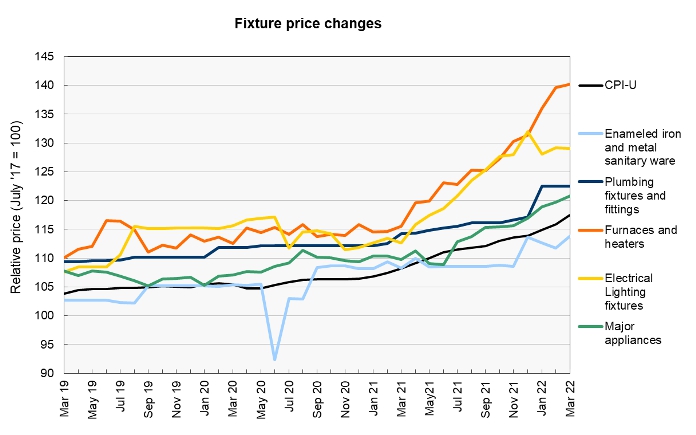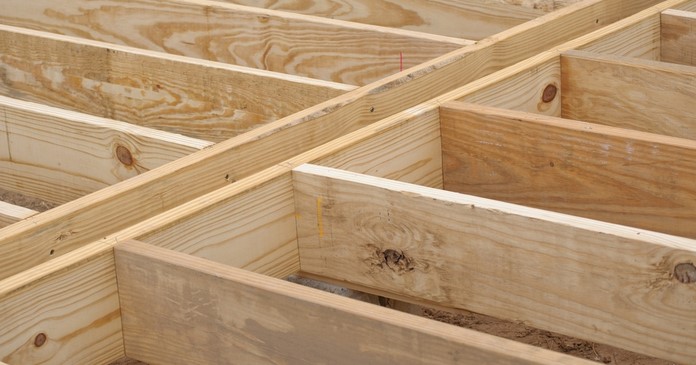The Bureau of Labor Statistics (BLS) released its producer price index report for March 2022. It stated that construction materials prices were up 1.5 percent in the month, seasonally adjusted. The index was 23.2 percent higher than its year-earlier level.
Overall prices for processed goods for intermediate demand rose by 2.1 percent in the month. That index was 21.7 percent higher than its year-ago level.
For reference, the changes in these indexes compare with an 8.5 percent rise in the all-items consumer price index (CPI-U) for the 12 months ending in March. The CPI-U was up 1.2 percent for the month. The shelter portion of the CPI was up 5.0 percent from its year-ago level.
Yield Pro compiled the BLS reported price changes for our standard list of construction commodities. These are commodities whose prices directly impact the cost of constructing an apartment building. The first two right hand columns of the table provide the percent change in the price of the commodity from a year earlier (12 Mo PC Change) and the percent change in price from February 2022 (1 Mo PC Change). If no price data is available for a given commodity, the change is listed as N/A.
The pre-COVID column lists the change in the current commodity prices relative to the average prices in December 2019 through February 2020, before the pandemic impacted the economy. This may give a truer idea of the magnitude of the recent price increases for commodities, such as lumber, whose prices were already rising sharply last year, than does the 12 Mo PC Change column.
| Commodity | 12 Mo PC Change | 1 Mo PC Change | Pre-covid Change |
| Softwood lumber | 23.1 | 7.6 | 143.2 |
| Hardwood lumber | 16.4 | -0.6 | 49.0 |
| General millworks | 15.0 | 0.5 | 21.3 |
| Soft plywood products | 25.3 | 2.8 | 173.2 |
| Hot rolled steel bars, plates and structural shapes | 44.2 | 5.5 | 77.7 |
| Copper wire and cable | 15.9 | 3.5 | 41.2 |
| Power wire and cable | 46.7 | 3.7 | 66.0 |
| Builder’s hardware | 16.6 | 0.6 | 20.0 |
| Plumbing fixtures and fittings | 7.2 | 0.0 | 10.6 |
| Enameled iron and metal sanitary ware | 5.1 | 1.8 | 8.3 |
| Furnaces and heaters | 21.3 | 0.4 | 23.5 |
| Sheet metal products | 32.5 | 1.8 | 41.4 |
| Electrical Lighting fixtures | 14.5 | -0.1 | 12.0 |
| Nails | 37.0 | 0.5 | 41.9 |
| Major appliances | 10.1 | 0.9 | 13.7 |
| Flat glass | 11.0 | 1.1 | 16.4 |
| Ready mix concrete | 8.2 | -0.4 | 10.8 |
| Asphalt roofing and siding | 21.6 | 1.6 | 28.6 |
| Gypsum products | 21.2 | 1.5 | 29.4 |
| Mineral wool insulation | 20.3 | 0.0 | 30.5 |
Previously, the price indexes for individual commodities published by the BLS were almost never revised after they were released. However, in recent months, revisions have been made to many of the component price indexes, some of them significant. These revisions will be discussed below.
The first chart, below, shows the price index history for wood products over the past 37 months. Note that the prices used by the BLS in compiling the indexes are collected on the Tuesday of the week containing the 13th day of the month. In March 2022 that would have been March 15.

In March, the price of softwood lumber edged out plywood to post the highest monthly percentage increase of the commodities we track, rising 7.6 percent. However, its annual price rise figure is starting to benefit from a comparison to a time last year when prices were rising strongly. Lumber was up only 23.1 percent year-over-year in March.
The market price of lumber has been in a downward trend since the middle of March, closing at $874 on April 12. This is down $546, or 38 percent, since our last report. Lumber prices in the futures markets have also been trending lower. The July 2022 contract closed at $798.50 on April 12. The September 2022 contract was at $765, down $130 over the last month.
In March, soft plywood products prices were reported to be up 2.8 percent. One of the reasons that the reported increase was this low is that the price index for February was revised upward by 3.4 percent, the largest upward price index revision for any item on our commodities list. Soft plywood prices were up 173 percent from their pre-pandemic level.
The prices of general millworks and hardwood lumber continue to move steadily higher in line with the overall rise in construction materials prices.
The next chart, below, shows the recent history of several other construction materials prices. These are the prices of relatively simple commodities whose prices are strongly driven by those of the materials of which they are comprised.

After a pause last month, the price indexes for copper wire and for power wire resumed their upward movement this month, with each rising 3.5 percent or more. This is in addition to upward revisions in the February price indexes of 0.8 percent for copper wire and of 1.2 percent for power wire.
The prices hot-rolled steel bars trailed only the wood products for the largest monthly increase in this report. Sheet metal product prices also moved higher, but the monthly price increase for nails was relatively mild, at least compared to the other construction materials prices we track.
MarketWatch reports that the NYSE American steel index resumed its upward movement in late March before reaching a plateau in April. It closed on April 13 at $2,044 up $262 from its level of a month ago. However, steel futures have moved lower over the last month. The July 2022 contract closed on April 13 at $1,340, down $319 since we last reported on it. The September 2022 contract is at $1,335.
The price of copper spiked shortly after Russia’s invasion, reaching $4.94 per pound on March 4. However, it closed on April 12 at $4.71, down from the peak but $0.19 higher that its close on March 14.
The price of aluminum has been volatile since early March. It closed on April 12 at $3,248, down $241 from its level of one month earlier. However, between these readings, it went as high as $3,684 on March 23.
The monthly rates of increase in the price indexes of asphalt roofing and siding and of gypsum were down slightly in March. They were about in line with the general increase in construction materials prices.
Price changes for several of the more finished goods from our sample are illustrated in the final chart, below. The increases in these construction materials prices were relatively moderate this month. The only one which had a higher reported rate of increase than that of general price inflation was enameled iron and metal sanitary ware, which had a reported increase of 1.8 percent. However, the February price index for this commodity was adjusted downward by 4.7 percent, the largest downward revision of any commodity we track. Compared to the preliminary price index reported last month, the price of enameled iron and metal sanitary ware was down 2.9 percent for the month of March.
 The full BLS report can be found here.
The full BLS report can be found here.












